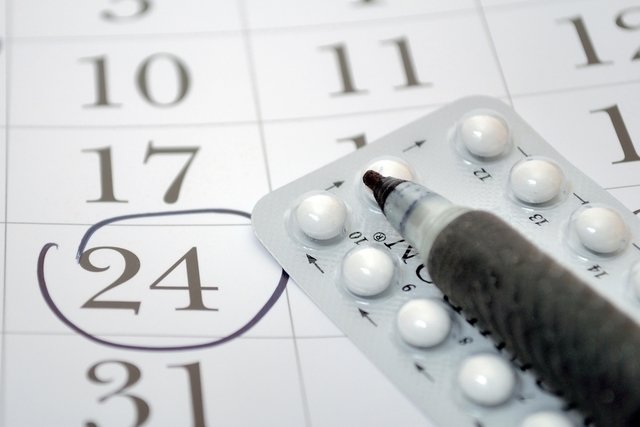Although it is a little more difficult to know exactly when the fertile period is in women who have irregular menstruation, it is possible to get an idea of what the most fertile days of the month might be, taking into account the last 3 menstrual cycles or evaluating the duration. of the cycle in the last 6 months to 1 year.
To do this, it is important that women write down the day of each cycle on which menstruation occurred, in order to know how many days each cycle lasted, to be able to calculate the most fertile days.
However, as the cycle is irregular, the fertile period identified through calculations may vary and, therefore, it is important to consult a gynecologist, in addition to paying attention to signs indicating the fertile period, such as increased body temperature and increased secretion. vaginal, and perform an ovulation test.

How to calculate
Calculating the fertile period in an irregular cycle can be more complicated, as ovulation and menstruation can occur on different days each month. Therefore, it is important that the gynecologist is consulted so that a more accurate assessment can be made.
If you want to make an appointment, you can find the gynecologist closest to you using the tool below:
Taking care of your health has never been easier!
However, there are some calculations that can be done to help you get an idea of the fertile period, but they should not be considered absolute truths, especially if the cycles are very irregular.
These ways of calculating the fertile period include:
1. Average of the last three months
To calculate the fertile period, the woman must take into account the last 3 cycles and write down the days on which the first day of menstruation occurred, determine the interval between these days and calculate the average between them. In other words, the step-by-step process for carrying out the calculation is as follows:
- Note the number of days in each cycle: cycle 1 – 33 days; cycle 2 – 37 days; cycle 3 – 35 days;
- Add each cycle: cycle 1 + cycle 2 + cycle 3 = 105;
- Divide the result of the sum by three: 105/3 = 35. This result corresponds to the average length of the menstrual cycle;
- Subtract 14 days from the average menstrual cycle length: 35 days – 14 days = 21. This result corresponds to the day of ovulation, that is, ovulation will occur on the 21st day of the cycle.
In this case, between one period and another, the most fertile days will be 5 days before and 2 days after ovulation, that is, between day 18 and day 24 after the first day of menstruation. However, as the cycle is irregular, the period can be variable.
2. Annual cycle
In this case, the cycle length must be recorded each month, for a period of 6 months to 1 year, to identify the longest cycle and the shortest cycle. Then, you must subtract 18 from the shortest cycle and 11 from the longest cycle.
For example, the longest cycle lasted 33 days and the shortest 26. Thus, 26 – 18 = 8 and 33 – 11 = 22, which is indicative that the fertile period should be between the 8th and 22nd day of the cycle.
However, especially in irregular cycles, this period can be variable. Furthermore, it is important to continue noting the length of the cycles and update the fertile period calculation regularly to check that the most fertile days are still the same.
How to know your fertile period
To know the fertile period in an irregular menstrual cycle, it is important to be aware of some signs that may appear during this period, such as increased vaginal secretion, increased body temperature, increased appetite and libido and mood swings, for example. See more about the signs of a fertile period.
When you notice these signs, it is possible to take an ovulation test, which can be purchased at pharmacies and aims to check the concentration of the LH hormone in the blood, which is increased during this period. Understand how the ovulation test is done and works.
To increase your chances of getting pregnant, in addition to carrying out an ovulation test to find out your fertile period and having sexual intercourse during this period, it may be recommended to have sexual intercourse at least every 3 days throughout the month, especially on the days where you can identify the signs of the fertile period.
How to protect yourself
For those who have an irregular cycle, the best strategy to avoid unwanted pregnancy is to take the contraceptive pill that will regulate the days of menstruation. Furthermore, it is also important to use a condom in all sexual relations to protect yourself from sexually transmitted infections.
Bibliography
- ACOG. Trying to Get Pregnant? Here’s When to Have Sex.. Disponível em: <https://www.acog.org/womens-health/experts-and-stories/the-latest/trying-to-get-pregnant-heres-when-to-have-sex>. Acesso em 07 dez 2023
- STATPEARLS. Physiology, Menstrual Cycle. 2022. Available at: <https://www.ncbi.nlm.nih.gov/books/NBK500020/>. Accessed on 07 Dec 2023
- CLEVELAND CLINIC. Rhythm Method. Available at: <https://my.clevelandclinic.org/health/articles/17900-rhythm-method>. Accessed on 07 Dec 2023
- MAYO CLINIC. Rhythm method for natural family planning. Available at: <https://www.mayoclinic.org/tests-procedures/rhythm-method/about/pac-20390918>. Accessed on 07 Dec 2023

Sign up for our newsletter and stay up to date with exclusive news
that can transform your routine!
Warning: Undefined array key "title" in /home/storelat/public_html/wp-content/plugins/link-whisper-premium/templates/frontend/related-posts.php on line 12
Warning: Undefined array key "title_tag" in /home/storelat/public_html/wp-content/plugins/link-whisper-premium/templates/frontend/related-posts.php on line 13



